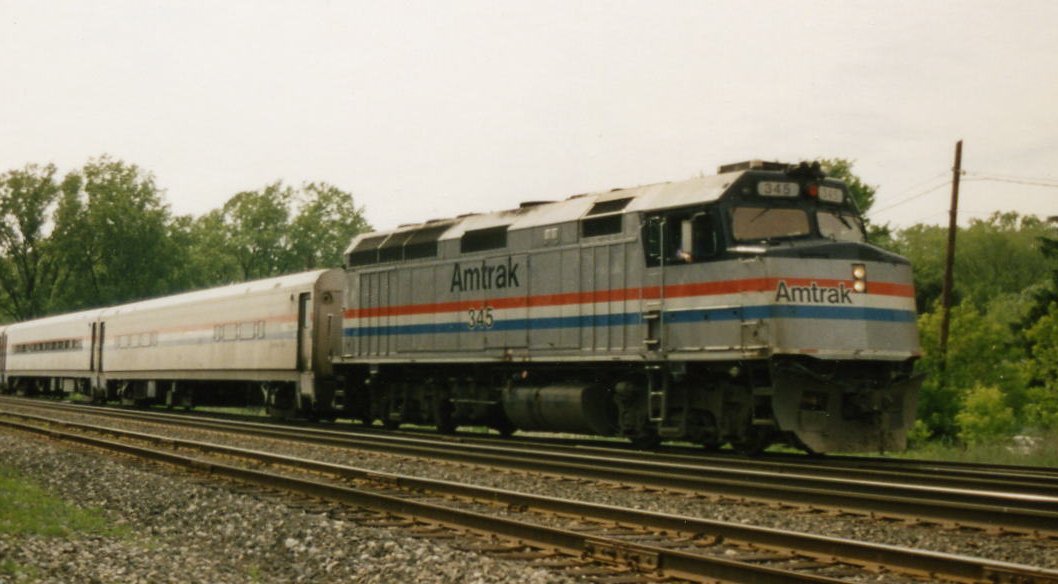- EMD F40PH
Infobox Locomotive Auto
name=EMD F40PH series
powertype=Diesel-electric
gauge=RailGauge|ussg

caption=AnAmtrak F40PH
builder=gm-emd
poweroutput=3,000 hp (2.2 MW)
aarwheels=B-B
builddate=1976 –1991
primemover=EMD 645E3
cylindercount=V16
topspeed=103 mph (166 km/h)
nicknames="screamer" "screaming thunderbox"|The General Motors Electro-Motive Division model F40PH is a 3000horsepower (2.2 MW) B-Bdiesel-electric locomotive intended for service onAmtrak 's intercity lines, built from1976 onwards.History
Introduction of the F40PH series was spurred as a replacement for the
EMD SDP40F type, Amtrak's first series of locomotives built new for them since inception in 1971. In some derailments the "hollow bolster" design of the SDP40F three axle truck became suspect as a possible cause. This led to the introduction of the F40PH, based on the provenEMD GP40 series freight locomotives using a two axle truck of known reliability. (The term "F40" by itself can lead to confusion, because the first locomotive to bear that designation was the F40C, a passenger C-C locomotive derived from the SD40-2, ostensibly similar to the SDP40F but with an HEP generator.)In later years, as Amtrak's F40PH fleet was being replaced by the newer
GE Genesis -series locomotives, Amtrak converted a number of the retired units—generally ones with major mechanical problems limiting their value in the resale or lease marketplacefact|date=June 2008—into "Non-Power Control Unit"cab car s. Commonly known as "Cabbages," aportmanteau of "cab" and "baggage," these units had their prime movers and traction motors removed, and a large roll-up door installed in the side, allowing the former engine compartment to be used for baggage. The units were renumbered into Amtrak's car-series numbers by adding "90" before the former locomotive number; thus, the original F40PH, number 200, became NPCU number 90200.Equipment
The F40PH is equipped with a turbocharged EMD 645E3 16 cylinder, two-stroke, water-cooled "Vee"
diesel engine (prime mover) that develops 3,000 tractive horsepower (2.2 MW) at maximum rpm. The main (traction) generator converts mechanical energy from the prime mover into electricity that is distributed through ahigh voltage cabinet to thetraction motor s. Each of the four traction motors are directly geared to a pair ofdriving wheel s. The gear ratio of the traction motors to wheel axle determines the maximum operating speed of the locomotive; a standard F40PH has a gear ratio of 57:20 which provides a top speed of 103 mph (166 km/h).The F40PH has a fully enclosed carbody which provides a cleaner, somewhat more streamlined appearance, than those of conventional
hood unit type construction. While enroute all-weather access to components is possible, passage through the engine room (and to trailing units) normally is used only during maintenance at repair points.To support passenger service, the F40PH is equipped with a secondary electrical generator known as the
head end generator . The HEP unit generates three-phase AC power at 480 v AC 750 A or about 500 kW to provide power to the cars for lighting, heating, and air conditioning. Because head end power must be delivered to the rest of the trainset at a constant frequency, the prime mover in these locomotives must turn at a constant high speed (900 rpm) while delivering head end power (even if the locomotive is standing still). Power to the traction motors is controlled by varying the field excitation of the main (traction) generator.Later versions of the F40PH have a second small diesel engine at the rear of the locomotive driving the head end power generator. In these versions the prime mover can vary its speed depending on the amount of tractive effort needed. These locomotives can be identified by a small secondary diesel exhaust at the rear end of the locomotive, in addition to their quiet idle. The MPI version of the F40PH was built by Morrison-Knudsen.
urvivors
There are currently a few ex-Amtrak locomotives that are in railroad museums, private owners and various commuter agencies; some of them are:
* AMTK 231, owned by Chris Fussell/Friends of SP 4449 in Portland, OR.
* AMTK 239, In Daily Service on the Grand Canyon Railway (GCRX 239).
* AMTK 281, California State Railroad Museum in Sacramento, CA.
* AMTK 295, Undergoing Rebuild for Revenue Service on the Grand Canyon Railway.
* AMTK 307, under restoration at the NCTM in Spencer, NC.
* AMTK 411, Agence métropolitaine de transport (AMT) 411, ex GO Transit 511
* AMTK 400, Agence métropolitaine de transport (AMT) 400
* AMTK 319, Agence métropolitaine de transport (AMT) 319
* AMTK 243, Agence métropolitaine de transport (AMT) 243
* AMTK 287, Agence métropolitaine de transport (AMT) 287
* AMTK 372, Agence métropolitaine de transport (AMT) 372
* AMTK 265, Maine Eastern Railroad 265
* AMTK 291, Maine Eastern Railroad 291
* AMTK 296, Metrolink LA / SCAX 800
* AMTK 399, Nashville Music City Star / MCS 122
* AMTK 398, Nashville Music City Star / MCS 121
* AMTK 332, Nashville Music City Star / MCS 120
* AMTK 390, CSXT 9992
* AMTK 395, CSXT 9993
* AMTK 280, CSXT 9998
* AMTK 288, CSXT 9999
* AMTK 365, VRE V33
* AMTK 283, Denver Ski Train, SKTX 283
* AMTK 242, Denver Ski Train, SKTX 242
* AMTK 308, MNCR 4193 (converted to F40PH-2CAT)
* AMTK 310, MNCR 4194 (converted to F40PH-2CAT)Variants
* EMD F40PH
* EMD F40PHR
* EMD F40PH-2
* EMD F40PH-2C
* EMD F40PH-2CAT
* M-K F40PHM-2C
* MPI F40PH-2C
* MPI F40PH-3CGallery
External links
* [http://hebners.net/amtrak/ Amtrak Photo Archives]
References
Wikimedia Foundation. 2010.
